Nectar-Feeding Bats and Birds Show Parallel Molecular Adaptations in Sugar Metabolism Enzymes
 Image credit: Stephen Rossiter
Image credit: Stephen Rossiter
Abstract
In most vertebrates, the demand for glucose as the primary substrate for cellular respiration is met by the breakdown of complex carbohydrates, or energy is obtained by protein and lipid catabolism. In contrast, a few bat and bird species have convergently evolved to subsist on nectar, a sugar-rich mixture of glucose, fructose, and sucrose. How these nectar-feeders have adapted to cope with life-long high sugar intake while avoiding the onset of metabolic syndrome and diabetes is not understood. We analyzed gene sequences obtained from 127 taxa, including 22 nectar-feeding bat and bird genera that collectively encompass four independent origins of nectarivory. We show these divergent taxa have undergone pervasive molecular adaptation in sugar catabolism pathways, including parallel selection in key glycolytic and fructolytic enzymes. We also uncover convergent amino acid substitutions in the otherwise evolutionarily conserved aldolase B (ALDOB), which catalyzes rate-limiting steps in fructolysis and glycolysis, and the mitochondrial gatekeeper pyruvate dehydrogenase (PDH), which links glycolysis and the tricarboxylic acid cycle. Metabolomic profile and enzyme functional assays are consistent with increased respiratory flux in nectar-feeding bats and help explain how these taxa can both sustain hovering flight and efficiently clear simple sugars. Taken together, our results indicate that nectar-feeding bats and birds have undergone metabolic adaptations that have enabled them to exploit a unique energy-rich dietary niche among vertebrates.